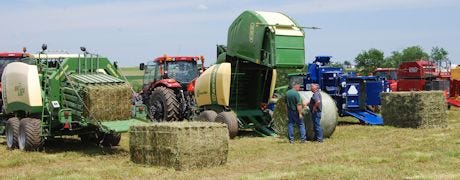
Keep an eye on baled hay that's being put in the barn. Especially if baled a little too wet, be sure to check for signs of heating.
That was a topic many representatives of hay harvesting machinery companies, and other exhibitors at the 2013 Farm Progress Hay Expo, were talking about last week. It's been raining a lot in June this year in Iowa, and much of the hay that's being baled is being put up a little wetter than usual. The Hay Expo was held near Waukon in northeast Iowa on the Regancrest Holsteins dairy farm June 19-21.

HOT HAY: Don't burn the barn down. Watch hay for signs of heating in storage. Iowa is getting plenty of rain this June, and hay is being baled a little wetter than it is normally harvested. That reminder was given to people attending the 2013 Farm Progress Hay Expo last week in at Waukon in northeast Iowa.
Heat produced by a bale basically comes from two sources, explains Brian Lang, an Iowa State University Extension field agronomist in northeast Iowa. Some heat is produced by biochemical reactions from the plants as hay cures. This heating is relatively minor and rarely causes hay temperature to rise above 110 degrees F. At this temperature, the hay suffers little damage.
If hay temperature rises above 170 degrees F, spontaneous combustion can occur
Most heat in hay, though, is caused by the metabolic activity of microorganisms, says Lang, who was answering farmers' forage and crop-related questions at the ISU Extension exhibit at the Hay Expo.
Millions of these microbes exist in all hay and they thrive when extra moisture is abundant, he explains. As the metabolic activity of these organisms increases, temperature of hay rises. Hay with only a little excess moisture probably will get no warmer than 120 degrees F. Wetter hay can quickly get as warm as 150 degrees F. Hay that gets this warm nearly always becomes discolored and nutritional value is reduced. If hay temperature rises above 170 degrees F, chemical reactions can produce enough heat to quickly raise temperatures and cause fires.
General guidelines to hay temperatures and precautions:
* 125 to 150 degrees F: This extra heat is generated by respiration of bacteria and spoilage fungi. At these temperatures chemical processes called the Maillard reaction causes hay to turn brown, protein digestibility decreases and the hay is said to be "caramelized."
* 150 to 175 degrees F: Check temperature daily. The caramelizing Maillard reaction continues. Consider reducing the volume of the warm hay by spreading the hay out. Caution! It may be dangerous to move hotter hay without fire department assistance.
* 175 to 190 degrees F: Check temperature every two to four hours. Alert the fire department of the situation and work with them on your management strategy. Chemical reactions which occur at these high temperatures begin to dominate the continued rise in temperature. Avoid addition of extra oxygen into the hot hay pile. Hay or silage that reaches these temperatures are often nearly black and have a much lower feeding value.
* 190 to 210 degrees F or more: Have the fire department present when hay is being removed. Spontaneous ignition is possible.
Measuring hay temperature. Best way to check temperature of hay is to drive a pointed tube about 8 to 10 feet into the hot hay. Lower a thermometer into the tube. A chemistry lab thermometer with a 200 to 300 degree F scale works well. Leave the thermometer in the tube for 10 to 15 minutes before reading. Hay may have "hot spots" so it is desirable to check in several locations.
About the Author(s)
You May Also Like




